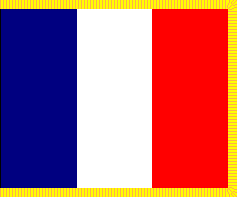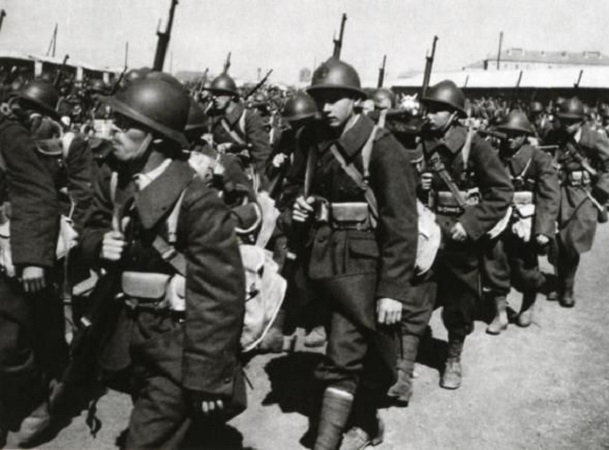The history of the French Army in
World War II falls into three chapters: 1939-40, culminating
in defeat and surrender; 1940-43, the “Armistice Army” of
Vichy; and 1940-45, the Army of Fighting France. The debacle
of May-June 1940 destroyed the Third Republic and its Army,
ushering in long years of occupation and bitter division
that witnessed French soldier in combat against other French
soldiers amid charges of treason on both sides. Only
gradually, under the auspices of DeGaulle’s government in
exile, was a French Army opposed to the Axis reconstituted,
so that by 1944-45 it was able to play a role in the final
stages of the war.
Since the founding of the Third
Republic, the French Army had been largely a conscript army.
In peacetime, the main business of its full-time
professional cadre was to train the annual intake of
conscripts. Relatively few divisions (but most of the
armored, mechanized and motorized ones) were maintained at
full strength in peacetime, some being stationed in the colonies. Many
colonial units, particularly those from French North Africa, were
considered part of the metropolitan Army and were included in its
mobilized order of battle.
In May 1940, on the eve of the German
invasion, the mobilized French Army comprised three armored
divisions (with one more in process of formation), three
light mechanized divisions (really armored divisions), seven
motorized infantry divisions, five light cavalry divisions
(partially mechanized), 101 infantry divisions (including
North African and colonial units) and 13 fortress infantry
divisions. Of these, 91 infantry divisions and all the
others listed were in metropolitan France. Those tanks not
with the armored and mechanized divisions were mostly in
armored groups of two or three battalions each, tasked with
the mission of infantry support. There were also a number of
separate mechanized brigades. Though some models dating from
the First World War remained in service, many French tanks
were modern and in terms of firepower and armor protection
they generally outclassed the tanks at the disposal of the
German Army. In other classes of weapons the two armies were
roughly comparable.

Command Flag for Army Group and Army
Commanders
The French Army’s organization and
operational doctrine were based on the experience acquired
in the First World War. This was most obviously symbolized
by the Maginot Line, the deep fortified zone covering the
French frontier opposite Germany. Contrary to popular belief
it was not a “Great Wall” on the Chinese model. French
military leaders recognized that in the event of another war
with Germany, the enemy’s main attack would probably come
through the Low Countries, as it had in 1914. To seal off by
fortification the French border with France’s ally, Belgium,
was clearly not feasible on either military or diplomatic
grounds. Thus Marshal Pétain,
when he was Chief of Staff in the 1920s, laid down that if
another German attack ever did come, “We must go into
Belgium.” With the common frontier well defended by fixed
fortifications, a significant portion of the French Army
would be free to advance against the attacking Germans—to
fight the decisive battle on Belgian, not French, soil.
French soldiers and politicians agreed that the devastation
of northwestern France that had occurred in 1914-18 must on
no account be allowed to happen again.
As for the French Army’s tactical
doctrine, it placed great stress on the defense, on the
domination of the battlefield by strong artillery
concentrations and on the carefully prepared set-piece
attack with tanks in direct support of the infantry. Having
learned to its great cost in 1914-18 what modern weapons
could do, the French Army placed its faith in firepower over
mobility. Significantly, there existed no unified tactical
doctrine for the employment of tanks. Unlike the German
Army, which brought all mechanized forces together in a
single arm of the service—the Panzerwaffe—French
tanks were shared out between the cavalry and infantry arms.
The light mechanized divisions and the partially mechanized
light cavalry divisions received light and medium tanks; the
armored divisions had medium and heavy tanks. Because of
this division of authority over armored forces, there was no
unified doctrine governing their employment. Particularly
unfortunate was the combination of mechanized formations
with horse cavalry formations in the light cavalry
divisions. Because of the great difference in capabilities
between mechanized and mounted units, they could not operate
together or provide useful mutual support. The existence of
the light cavalry divisions in 1940 shows that the French
Army's senior leaders did not really grasp the military
potential of mechanization.
There were also some significant
deficiencies at the small-unit level. For example, many
French tanks lacked a radio. Usually only the platoon or
company commander's tank had one, for communication with
higher headquarters. To communicate with the
tanks under his command, the commander had to rely on
flag or hand signals. But in the panzer divisions every tank
was equipped with a radio, endowing German armored
formations with a flexibility that the French ones lacked.
German medium and heavy tanks also had larger crews than
comparable French tanks. The French S35 SOUMA medium tank
was well armed and armored but had a crew of only three
(commander/gunner, radio operator/loader, driver)—imposing
an excessive workload on the commander. The German Panzer
III, on the other hand, had a crew of five (commander,
gunner, loader, driver, radio operator)—enhancing the
individual tank's tactical flexibility. Finally, on the
French side there was no real provision for close air
support of ground forces—this again in sharp contrast to
German tactical doctrine.

French infantry, 1939-40
(Photo:
Musée de l'Armée)
Most of the Army's
101 infantry divisions relied largely on horses to move
their artillery and supplies. Organizationally they were
very similar to the infantry divisions of the German Army:
three infantry regiments, each with three battalions. The
seven motorized infantry divisions were the same, but with
motor vehicles replacing horses in the artillery and other
support units and an attached motor transport group for the
infantry regiments. At the corps level there was a heavy
artillery regiment and a corps reconnaissance group.
On the operational level French Army’s
organization for combat was much the same as other armies.
Field armies embodied two or three corps headquarters (Corps
d'Armée) and
eight to ten divisions of various types which were attached
to the corps or held under army control. In May 1940 there
were nine field armies in all, divided among three army
groups (Groupes d'Armées). Most of the armored and
mechanized units were allotted to the
1e
Groupe d'Armées
for the advance into Belgium.
Operationally as well as tactically,
the French Army remained wedded to the deliberate approach. It was assumed that operations—the deployment
and maneuvering of large units—would take place at much the
same pace as in days gone by. Movements and attacks would be
carefully planned in advance; they would be launched only
when all preparations were complete. That such deliberation
risked yielding the initiative to an enemy more flexible and
opportunistic in his approach occurred to few, and this was
a major cause of the French debacle on the spring of 1940.